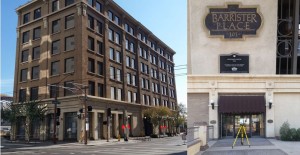3 buildings preserved in time by laser scanning
 Laser scanning is a process that is becoming more widespread every day. Eventually, it will be used for so many aspects of our lives it will be like the camera, and we’ll wonder what we ever did without it. As laser scanning becomes more accessible, more uses for it are being discovered. Of course, laser scanning is an incredible tool for land and building surveying, but it has so many more amazing uses.
Laser scanning is a process that is becoming more widespread every day. Eventually, it will be used for so many aspects of our lives it will be like the camera, and we’ll wonder what we ever did without it. As laser scanning becomes more accessible, more uses for it are being discovered. Of course, laser scanning is an incredible tool for land and building surveying, but it has so many more amazing uses.
One of our favorite uses for laser surveying is historical preservation. So much artistic and creative expression goes into the architecture of buildings. So often, every aspect of a building tells a story, and each day that passes that story changes. The structure of a building speaks to the time it was built and the people who worked on it, and every crack, erosion, or vine of ivy that nestles into the building tells the story of the people who have been there, and the way the world has changed around it. Not only are these details interesting, they’re also important to notice so that we can understand our history better. That’s where laser scanning comes in. Laser scanning creates a three dimensional digital replica of a building in detail as it is in a precise moment in time, so that we can know what it looked like at that point for years to come. Lots of historical buildings are going through the process of being laser scanned, and we’d like to share a couple today!
1. Belsay Castle
This Medieval Greek revival castle in England was built in 1370 to serve as a home for a wealthy English family at the time, but has since served as a home to many different families and facilities. There have been many changes made to this building in its nearly 700 years of existence including quite a few add-ons and demolitions. Amazingly, most of what still stands of Belsay is its original three story story structure.
When it comes to understanding how people in history lived, it can be difficult to truly imagine them as real people until you step into their world, and stepping in to where they would have truly lived out their every day lives is one of the best ways to do that. Belsay castle is an incredible look into what everyday medieval life might have been like for the non-royal wealthy. Belsay castle has been laser scanned recently so that in another 700 no matter what’s left of Belsay, we can still learn from what it looks like now.
2. Canterbury Cathedral
Another amazing historical addition to the buildings that have been laser scanned is Canterbury Cathedral. Canterbury Cathedral serves as a breathtaking example of why it’s important to learn from what buildings look like right as they are in this time period, to the accuracy of laser scanning, because of its incredibly unique erosion. In case any of you were asleep in high school English during the reading of Chaucer’s “The Canterbury Tales,” the Canterbury Cathedral was a wildly popular destination for religious pilgrimages during the 14th century.
People from all over Europe would journey to the cathedral to pray next to the tomb of St. Thomas Beckett. For most modern people (Americans, especially, because our country is still quite young) to imagine this as anything other than a story until they see Canterbury Cathedral. Next to the famous tomb of St. Thomas Becket, there are two distinct, deep pockets of erosion in the stone floor where millions of knees have knelt in prayer. a Photo doesn’t quite do them justice, but recently, the building has been laser scanned, and a 3D model created. Because of laser scanning, even if someone never gets to make the pilgrimage to see Canterbury Cathedral, they can still understand its historical magnitude.
3. The Barrister Building
The last building we’ll talk about is one that is far more modern, and quite meaningful to us at McNeil, the Barrister Building in downtown Phoenix, Arizona. The Barrister Building, formerly the Jefferson Hotel, was built in 1915, and if you’re a fan of classic films, you’ll probably recognize it. Alfred Hitchcock’s 1960 masterpiece, “Psycho,” contains some of the most famous and highly regarded sequences in film history. This, of course, includes the shower sequence that made strings the permanent instrument of choice when it comes to striking fear. This also includes the opening sequence, where an aerial shot of Phoenix brings the viewer right up close and personal to the Jefferson Hotel and in through a window, bringing the viewer into the intimate personal lives of the characters. Here at McNeil, we were lucky enough to have been commissioned to do the historical laser scan of the historic Barrister Building before its renovation after it was purchased in 2016. You can learn more about our work on the Barrister building here.

